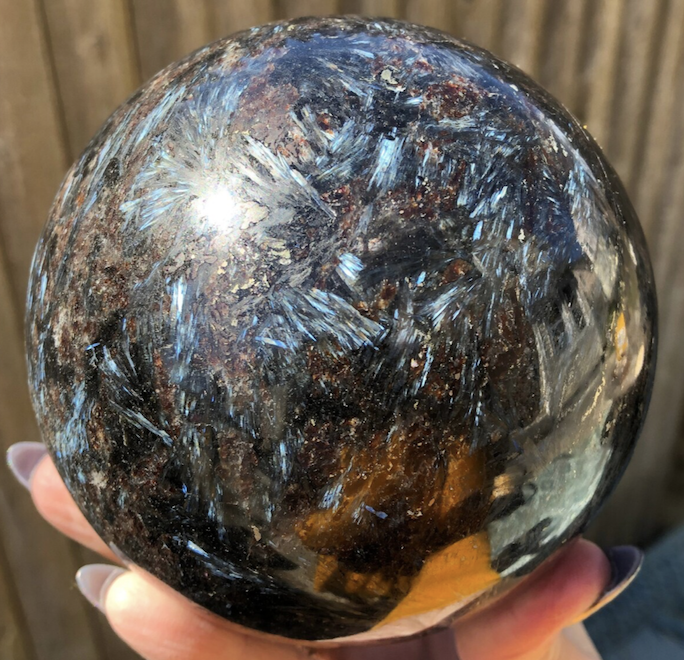
Arfvedsonite or Astrophyllite? Neither!
I’ve seen this same stone popping up at trade shows and supplier warehouses for years now, with several different names. Many suppliers call it “Fireworks Stone,” I see lots of it online sold as “Astrophyllite” or “Arfvedsonite.” I’ve seen lots of metaphysical sites comparing the two and proclaiming them to be one or the other. I have spent a long time trying to figure it out and in the past have settled for calling it Arfvedsonite just because I have to call it something. But there are many inconsistencies with those labels when it comes to the stone in question.
First the easiest one - “Fireworks Stone” is not a name of any mineral accepted by any reputable mineral or gem organization. It doesn’t mean anything and doesn’t tell us anything about what it actually is or the minerals in it. We call this a marketing or trade name - someone made it up to sell more rocks because it sounded cool or they didn’t actually know what kind of stone it was- or both.
Next, Astrophyllite. It forms gold, iridescent sprays much like the ones seen in the material in question. However, according to Mindat its color is “bronze-yellow, golden yellow, brown to reddish brown.” The stones that I have seen of the mystery material often have more blue than gold and yellow. Sometimes they are more gold too, but it cannot be Astrophyllite when so much of this material is so very blue. Astrophyllite also occurs more in radial “sun” shapes which often form full circles. Our mystery stone forms more often in “brush” shapes like a paintbrush pressed against a surface.
The third contender is Arfvedsonite. This is what I most commonly see this stone called online. If you post it in a mineral ID group, there will always be someone (never one of the geologists or mineralogists) who jumps to argue that it is Arfvedsonite. Mindat says the color of Arfvedsonite is “bluish-black to black” and in their gallery of 225 photos of Arfvedsonite specimens, all of them look closer to a Black Tourmaline than the material we are trying to identify. Every photo from a reputable source appears much like this photo - very dark or black crystals. Nothing iridescent gold or blue at all.
Finally after many hours spread over several years down this rabbit hole I believe I have found the answer. The name of the mineral in question is Anthophyllite. Anthophyllite is a fibrous amphibole mineral. It is also iridescent but can have gold, yellow, green, blue, and brown - so the iridescence of Anthophyllite fits much better than either of the other minerals it is often called.
On Mindat, there is a photo in the gallery for Anthophyllite that very much resembles the mystery material. It is labeled “Anthophyllite, Garnet, Cordierite.” The piece that I currently have does appear to have a lot of sparkly Almandine Garnet, which makes it a much more believable identification than other minerals. I have often seen the red part of this material called Eudialyte, but none of the aforementioned minerals appear to occur much in association with Eudialyte. My guess is that someone assumed it to be Eudialyte because that is a red mineral associated with Astrophyllite. Anthophyllite, on the other hand has both Garnet and Cordierite listed under common associates.
Another mineral listed under Anthophyllite’s common associates is Gedrite. This is interesting because Gedrite looks pretty similar to Anthophyllite, occurring in fibrous sprays, but is mostly black or dark green. The photo on the left here is Gedrite with Garnet. In the material I have now, shown on the right, there is a lot of shiny black sprays that are around the golden ones, and Anthophyllite and Gedrite do indeed occur together. Random fun fact- Gedrite and Anthophyllite alone together have a trade name you’ve probably heard before - Nuummite!
I found an article on Epigem that talks about this stone pictured, found in Sweden and described as an Anthophyllite schist “with reddish brown garnet, granular epidote and colorless cordierite.” This makes so much sense because so many of the pieces of this material I’ve had also had bits of green in them, and the one I’m looking at now does have some areas of clear stone that appears to sparkle similar to other cordierites I have had. In comparison, Cordierite does not often occur with Arfvedsonite, which mostly forms on Feldspars. It is also not listed as an associated mineral of Astrophyllite. So again, it seems that Anthophyllite is the most likely identification of these no-longer mysterious iridescent blue and gold sprays.
How Do Crystals Get Their Colors?
There are so many different crystals and gemstones that exist in nature, and collectively they have an incredibly vast range of colors all over the spectrum. Some types of gemstones can have several different colors, like Topaz, Quartz or Tourmaline. So how do they get their colors?
In their chemical structure, gemstones have trace amounts of different transition metals either as part of their chemical compound or as impurities. Transition metals are the metals that make up the large, middle part of the Periodic Table, and these metals are able to absorb colored light. Different wavelengths of visible light can be absorbed by different transition metals, leading to the different colors that we see.
Purple Amethyst - colored by the irradiation of Iron ions in place of Silicon
For example, the purple coloring of Quartz that we call Amethyst is caused by the irradiation of Iron ions in place of Silicon in some locations of the structure.
Garnet’s red coloring is caused by Iron ions replacing Magnesium ions, and the lovely blue variety of Beryl that we call Aquamarine is from the presence of Iron ions replacing Aluminum ones.
The yellow color of Citrine - another form of Quartz- is caused by Aluminum or Iron impurities.
In Emerald, Chromium ions replacing Aluminum creates green. In Ruby it creates red!
Topaz in it’s pure form is colorless, while atomic level imperfections cause the blue, yellow and brown varieties.
Topaz in it’s pure form is colorless, while atomic level imperfections cause the blue, yellow and brown varieties.
Transition metals are not the only way that gemstones get their colors, however. In some stones, such as Sapphires, it is caused by the transfer of electrons between ions.
Color can also be caused when an ion in a specific place is missing within the structure, or diffraction of light through the structure, like in an Opal.
Simple inclusions of tiny minerals inside a larger solid crystal can change its color. For example if a clear crystal like Quartz or Apophyllite or Calcite has red Hematite in it, the color of the crystal itself can appear to be red.
These are the most common reasons for the colors of crystals, or at least their colors as they appear to the human eye. There are more reasons, for more complicated crystals such as Alexandrite, Labradorite and some Fluorites. Crystals are complicated and the more you learn, the more complex they become!
















